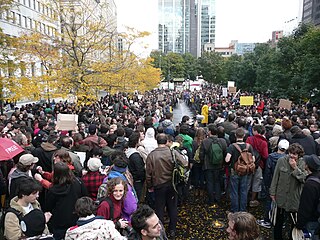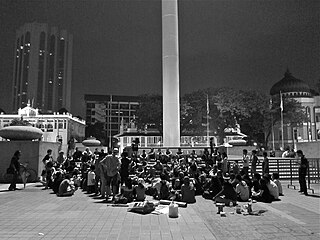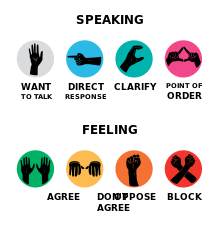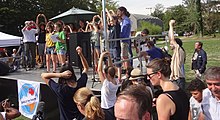
Consensus decision-making or consensus process are group decision-making processes in which participants develop and decide on proposals with the goal of acceptance by all. The focus on establishing agreement of at least the majority or the supermajority and avoiding unproductive opinion differentiates consensus from unanimity, which requires all participants to support a decision.

Occupy Wall Street (OWS) was a 59-day left-wing populist movement against economic inequality and the influence of money in politics that had begun in Zuccotti Park, located in New York City's Wall Street financial district, and lasted from September 17 to November 15, 2011. The protests gave rise to the wider Occupy movement in the United States and other Western countries.

Occupy Los Angeles is one of the many occupy movements in the United States, following the original Occupy Wall Street (OWS) protest. Participants of Occupy L.A. first met at Pershing Square on September 23, 2011. Activists came to consensus to occupy public space in solidarity with the growing movement. Occupiers first marched in Los Angeles on September 24, 2011. They next protested a fundraiser being held in Hollywood at the House of Blues for President Obama. Participants met at Pershing Square every subsequent night to plan out the logistics of an occupation set to begin on October 1, 2011. After debating potential locations around Los Angeles, people decided on the lawns around City Hall. Tents first manifested on October 1, 2011 on the grounds of Los Angeles City Hall.

Occupy Seattle was a series of demonstrations in Seattle, Washington, United States in 2011 and 2012, that formed part of the wider Occupy movement taking place in numerous U.S. and world cities at that time. The demonstrations were particularly focused on the city's downtown area including Westlake Park and Seattle City Hall; their stated aim was to oppose wealth inequality, perceived corporate greed, and corruption in the banking and economic systems of the United States.
Occupy Atlanta has included protests and demonstrations. Occupy Atlanta began on October 6, 2011 in Woodruff Park, located in downtown Atlanta, Georgia. As part of the Occupy movement, it is inspired by Occupy Wall Street which began in New York City on September 17.

The Occupy movement was an international populist socio-political movement that expressed opposition to social and economic inequality and to the perceived lack of "real democracy" around the world. It aimed primarily to advance social and economic justice and different forms of democracy. The movement has had many different scopes, since local groups often had different focuses, but its prime concerns included how large corporations control the world in a way that disproportionately benefits a minority, undermines democracy and causes instability.

Occupy Canada was a collective of peaceful protests and demonstrations that were part of the larger Occupy Together movement which first manifested in the financial district of New York City with Occupy Wall Street, and subsequently spread to over 900 cities around the world.

The 15 October 2011 global protests were part of a series of protests inspired by the Arab Spring, the Icelandic protests, the Portuguese "Geração à Rasca", the Spanish "Indignants", the Greek protests, and the Occupy movement. The protests were launched under the slogan "United for #GlobalChange", to which the slogan "United for Global Democracy" was added by many people's assemblies. The protest was first called for by the Spanish Plataforma ¡Democracia Real YA! in May 2011 and endorsed by people's assemblies across the world. Reasons were varied but mainly targeted growing economic inequality, corporate influence over government and international institutions, and the lack of truly democratic institutions allowing direct public participation at all levels, local to global. Global demonstrations were held on 15 October in more than 950 cities in 82 countries. The date was chosen to coincide with the 5-month anniversary of the first protest in Spain. General assemblies, the social network n-1, mailing lists, Mumble voice chat, open pads such as Pirate Pad and Titan Pad, and Facebook were used to coordinate the events. Some protests were only a few hundred in number, whereas others numbered in the hundreds of thousands, with the largest in Madrid numbering half a million and the second largest city Barcelona with 400,000.

Occupy Dataran was an autonomous grassroots movement based in Kuala Lumpur, that aims to create a platform to experiment participatory democracy based on the popular assembly model. The Malaysian Insider reported that Occupy Dataran was an offshoot of Occupy Wall Street. The online news portal also reported that the Malaysian protesters were expressing solidarity with the New York protest movement as part of the 15 October 2011 global protests. However, it is widely acknowledged that the first Occupy Dataran assembly was held on 30 July 2011, seven weeks before Occupy Wall Street.

Occupy Eugene was a collaboration that occurred in Eugene, Oregon based on the Occupy Wall Street movement which began in New York City on September 17, 2011. Occupy Eugene included peaceful protests and demonstrations. Protesters were concerned about inequities in the distribution of wealth, banking regulation, housing issues and corporate greed. The first protest march was held on October 15, 2011. The march started at the Wayne Morse Free Speech Plaza and continued downtown before marching over Ferry Street Bridge. It was reported that close to 2000 people were in attendance from all over the state of Oregon. Occupy Eugene continued to hold regular protests and actions until it left the encampment in December 2011. Protesters have stated that they do not have a set group of leaders. Occupy Eugene General Assemblies have met from as frequently as twice a day at times during active occupations, and as infrequently as weekly. Many committees have met since at least the third General Assembly, typically weekly. Decisions are made through a process known as consensus. Occupy Eugene's consensus process operates in a similar fashion to how consensus is being handled in New York City by protesters involved in Occupy Wall Street. Although the exact method varies from Occupation to Occupation. As of October 18, 2011, The Eugene police department was allowing protesters to camp in downtown Eugene, although city law prohibits it. Eugene police also stated that downtown camping won't be permanently allowed.

A human microphone, also known as the people's microphone, is a means for delivering a speech to a large group of people, wherein persons gathered around the speaker repeat what the speaker says, thus "amplifying" the voice of the speaker without the need for amplification equipment.
Occupy San Diego was one of the many occupation protest movements in the United States. Located in San Diego, California, the protest movement initially began in the city's downtown district at the Civic Center. According to authorities, it had "a growing problem with violence and mounting trash". However this assertion was disputed by protesters and eyewitnesses, since Occupy protesters have been actively cleaning the site since October, 2011. It is based on the Occupy Wall Street movement that began in New York City on September 17 and is one of several "Occupy" protest sites in the Southern California, including Occupy Los Angeles.
Occupy Las Vegas was an occupation and peaceful protest that began on October 6, 2011. It is affiliated with the Occupy Wall Street movement that began in New York City, and also with the "Occupy" movement in the United States and around the world. A series of meetings that were titled "The General Assembly" or "GA" were held to plan the beginning of the event on October 6, 2011, and were held to create a consensus on policies and planning for the occupation.

The Occupy movement began in the United States initially with the Occupy Wall Street protests in New York City, but spread to many other cities, both in the United States and worldwide. This list article is an alphabetical, non-chronological summary of Occupy events that have occurred in cities in the United States.
The Thames Valley Climate Action is an Oxford-based environmental group.
Occupy South Africa was a South African initiative primarily aimed at protesting and inciting mass action against the racial, economic and social inequality in South Africa. It is part of the globally Occupy Wall Street movement. It consists of a loose informal affiliation of on the ground groups and individuals across South Africa as well as internet based groups. Groups such as Taking Back South Africa!, Occupy South Africa are involved in South Africa and online. The movement is also involved with the Marikana miners' strike.

General assemblies (GA) were the primary decision making bodies of the global Occupy Movement which arose in 2011. Open to all who wished to take part, general assemblies allowed for an inclusive form of direct democracy. Such assemblies aimed to establish a consensus among all participants.
Jeffrey Juris was an American professor who taught anthropology at Northeastern University. Juris received a Ph.D. in anthropology from UC Berkeley. Beyond being an educator, Juris was an author, political activist, and researcher. Juris specializes in social movements, transnational networks, new media activism, and political protests. He had a number of published books and maintained his own website, where he updated his publications and political activism. Juris was cited and referenced many times for his research on the Occupy movement and other anti-globalization movements.










